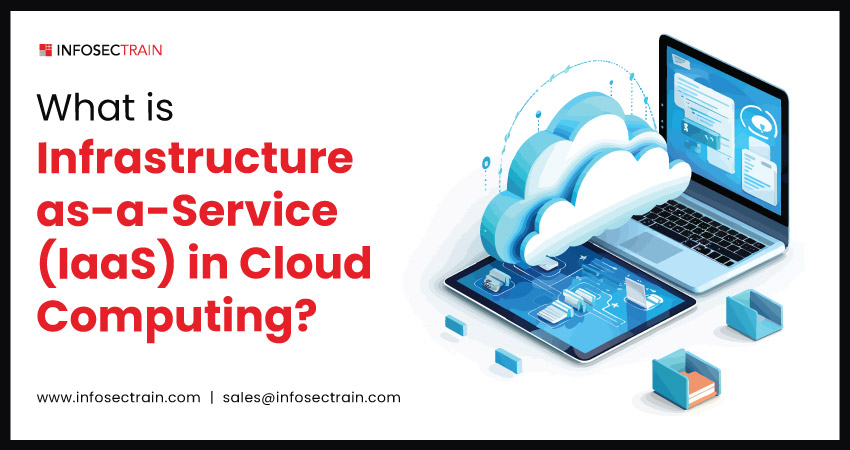What is Infrastructure-as-a-Service (IaaS) in Cloud Computing?
Cloud computing has fundamentally altered the information technology landscape, reshaping how organizations and consumers harness computational power. Within the cloud computing ecosystem, Infrastructure-as-a-Service (IaaS) stands as a foundational pillar, providing a flexible and scalable solution for providing essential computing infrastructure over the Internet. As organizations strive to optimize their operations, enhance agility, and overcome the challenges of managing traditional on-premises infrastructure, IaaS presents a compelling solution. This cloud computing model gives users unprecedented control over their computing environments, allowing for dynamic customization and scaling.

Table of Contents
What is Infrastructure-as-a-Service (IaaS)?
How does Infrastructure-as-a-Service (IaaS) Work?
Types of Infrastructure-as-a-Service (IaaS) Solutions
What is Infrastructure-as-a-Service (IaaS)?
Let’s understand IaaS with an example. You need a powerful computer to run your business applications, store data, and handle your network traffic, but buying and maintaining all this equipment sounds overwhelming and expensive. This is where Infrastructure as a Service, or IaaS, comes in to save the day.
IaaS is like renting all the IT resources you need over the Internet instead of buying and managing them yourself. It is like a virtual toolbox filled with computing power (processing capability), storage (space for data), and networking resources (connecting your systems) you need to keep your business running smoothly. You can access and use these resources anytime and only pay for what you use.
IaaS offers a scalable and flexible solution for businesses and individuals to rent computing infrastructure rather than owning and maintaining physical hardware. Users can create, configure, and manage virtual servers and other resources through a web-based dashboard or API (Application Programming Interface). This model prevents the need for initial hardware capital expenditures, lowers operational expenses, and enables quick scaling in response to fluctuating demand.
How does Infrastructure-as-a-Service (IaaS) Work?
Infrastructure-as-a-Service (IaaS) delivers virtualized computing resources via the Internet, allowing customers to access and manage critical infrastructure components without owning or maintaining physical hardware. The IaaS model involves a cloud service provider offering a pool of computing resources, which customers can rent and utilize as needed. Here’s how IaaS works:
- Provisioning Resources: Users select and request the amount of computing power, storage, and networking resources they need through an online portal or API.
- Virtualization: The IaaS provider uses virtualization technology to partition physical servers into multiple virtual machines (VMs), allowing efficient resource utilization.
- Resource Pooling: The cloud provider pools computing resources like processing power, storage, and networking to serve multiple customers efficiently.
- On-Demand Self-Service: Users can independently provision and manage resources without needing intervention from the cloud provider. This flexibility allows for the rapid deployment and scaling of resources as required.
- Elasticity and Scalability: IaaS allows users to easily scale their infrastructure up or down, depending on workload fluctuations, ensuring optimal resource utilization and cost-effectiveness.
- Pay-as-you-go Billing: Like a utility billing model, users are often charged based on their actual usage, allowing them to pay only for the resources they consume.
- Global Accessibility: With an internet connection, users can access and manage their IaaS resources from anywhere, enabling distributed teams and global collaboration.
Types of Infrastructure-as-a-Service (IaaS) Solutions
- General-Purpose IaaS: These are standard IaaS offerings that provide a broad range of virtualized computing resources, including virtual machines, storage, and networking, suitable for various applications and workloads.
- Compute-Optimized IaaS: These IaaS solutions are tailored for workloads that require high computational power, such as CPU-intensive applications, scientific simulations, and data analytics.
- Memory-Optimized IaaS: Memory-optimized IaaS instances are designed for applications that require large amounts of RAM, such as in-memory databases or big data processing.
- Storage-Optimized IaaS: These solutions are optimized for high-capacity storage needs, making them suitable for applications with extensive data storage requirements, such as databases and data warehousing.
- GPU-Enabled IaaS: These instances come with specialized Graphics Processing Units (GPUs) that are ideal for tasks like deep learning, artificial intelligence, and video rendering.
- FPGA-Enabled IaaS: Field-Programmable Gate Arrays (FPGAs) can be used for highly specialized computing tasks, and FPGA-enabled IaaS instances cater to workloads that can benefit from this technology.
- Containerized IaaS: Some IaaS providers offer container-focused solutions, enabling users to deploy and manage containerized applications seamlessly.
- Serverless IaaS (Function-as-a-Service): Although not strictly IaaS, serverless computing platforms like AWS Lambda or Azure Functions offer a form of event-driven computing where developers focus solely on their code and the cloud provider manages the underlying infrastructure.
Cloud Computing with InfosecTrain
Infrastructure-as-a-Service (IaaS) in cloud computing offers flexibility, scalability, and cost-efficiency, aiding organizations in better infrastructure management. Understanding its advantages, challenges, and implementation is vital for successful adoption. Evaluate requirements, choose the right provider, and effectively manage the IaaS environment to drive innovation and growth.
If you want to enhance your cloud computing skills further, we highly recommend you check InfosecTrain’s Cloud Security Practitioner training course. This program delivers comprehensive knowledge of cloud computing, covering IaaS, governance, risk, compliance, business continuity planning, and disaster recovery. It equips security professionals with deep insights into cloud security, the associated challenges, and strategies for addressing various cloud security concerns.







 1800-843-7890 (India)
1800-843-7890 (India) 